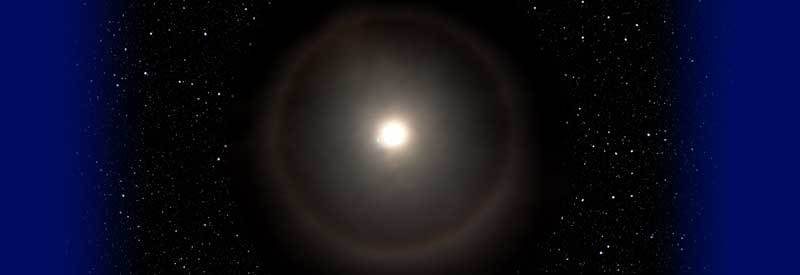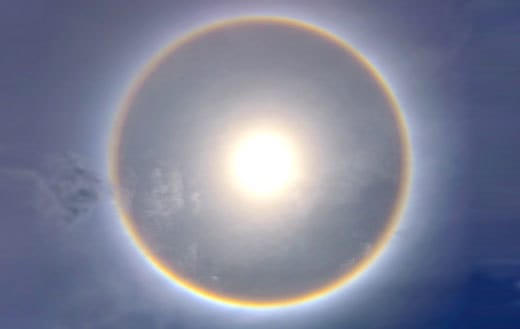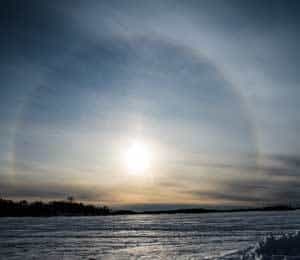Solar Halos – Defining The Rings Around The Sun

Occasionally, while looking up at the sky, one may notice a hazy rainbow-coloured ring around the sun. This phenomenon is better known as a solar or 22-degree halo, but what is this occurrence?
Solar or 22-degree halos are defined as hazy rainbow-colored rings occurring at a radius of approximately 22 degrees around the sun. It results from the sun's light being refracted by ice crystals in Cirrus clouds in the upper troposphere at altitudes of approximately 6000 meters or 20 000 feet.
These multi-colored optical phenomena can occur quite frequently and are not an unfamiliar sight, yet very few people really know what exactly these rings around the sun are or how they are formed.
This article examines what these rings (or solar halos) are and how they are created. It also looks at its characteristics and the conditions surrounding it.
What Is A Solar Halo?
The introduction already provided a brief description of what this spectacular-looking meteorological phenomenon around the sun is. To better understand its formation, though, one first needs a more elaborate and detailed definition.
Solar Halo Definition

Rings (or halos) around the sun are the refraction of the sunlight by millions of ice crystals present in cirrus clouds drifting at a height of 6000 meters (20 000 feet) or more above the earth's surface.
The hazy rings appear at a radius of approximately 22 degrees around the sun, which are characterized by various degrees of predominantly rainbow colors and an undefined, fuzzy border.
It occurs in the upper troposphere, where temperatures are too low for water droplets to remain in their liquid form. The hexagon shape of the ice crystals breaks the sunlight up and refracts back to Earth.
A solar halo goes by many different names. Sometimes it is simply referred to as "the ring around the sun." The scientific community refers to it as a 22° halo, but it is also known as a halo, sun halo, 46° halo, or rainbow halo.
The color of a solar halo varies from a faint rainbow color to a pale white tint. The rainbow colors are the result of the ice crystals breaking up the white light into its primary colors. Sometimes, though, the primary colors combine and blend together to form a white tint.
(The hue and intensity of the color largely depend on the strength of the sunlight, density of the clouds, and the angle of refraction.)
The halo is not visible to everyone where the sun shines through Cirrus clouds. It depends on your physical location in relation to the position of the sun. Depending on your position, the ice crystals refract the light from the sun at just the right angle to see the occurrence.
A solar halo is exactly the same phenomenon that occurs during the daytime around another celestial body. The halo you see around the moon is the same meteorological phenomenon. Instead of sunlight, though, it is the moonlight that is refracted in this case.
What Causes The Ring Around The Sun
As mentioned in the previous section, the rings you see around the sun result from the ice crystals in cirrus clouds refracting and reflecting the light in such a way that you can see a ring appearing from your location on the planet's surface.
A few things need to be in place in order, though, to observe these rings surrounding the sun clearly.
- The presence of the sun in a mostly clear sky.
- 2Secondly, a clear sky with only a thin layer of cirrus clouds high up in the atmosphere is essential. (Thicker clouds present lower down in the atmosphere will obscure or eliminate the effect.)
- 3As the light from the sun hits the cirrus cloud, it gets refracted and "bend" by the ice crystals. The refraction by the ice crystals causes the light to be projected in a different direction.
- 4If the light is refracted or "bend" at a certain angle, specifically 22 degrees, the rings will become visible to the observer. (This also means the rings have a radius of about 22 degrees around the sun.) That is why this occurrence is also referred to as 22-degree halos by scientists and meteorologists.
As already mentioned, an individual also has to be in the right geographical location on the planet's surface )in relation to the sun's location) to observe this phenomenon.
Characteristics Of The Rings Around The Sun
A notable feature of the halo surrounding the sun is the lack of a clear and well-defined border. The fuzzy border is the result of millions of ice crystals refracting the light in multiple directions that it makes it impossible to create a clear and well-defined border.
The ring around the sun has a mostly rainbow-colored hue but can also display a pale white color as a result of primary colors blending together and canceling each other out. This a direct result of the hexagon shape of the ice crystals.

Like the shape of raindrops causing the different colors in a rainbow to appear, the faceted (hexagon) shape of ice crystals refracts the light of the sun and breaks it up into its primary colors.
This is why you will occasionally notice some rings around the sun to have a red tint on the inside and a blue tint on the outside.
As the sun is much brighter than the moon, the rings around the sun not only display a rainbow-colored hue but also appear much brighter and clearly defined due to the increased luminescence.
What is also very noticeable is the fact that the sky between the edge of the sun and the halo always appears darker than the rest of the sky.
On rare occasions, one may also catch a very rare glimpse of not one but a double halo surrounding the sun.
Halo Around The Sun Superstition
Over centuries, many cultures worldwide believed a ring around the sun is a sign that rainy weather is on the way. This is neither a myth nor a superstition. The presence of high cirrus clouds is very often an indication of wet and stormy weather on the way.
Cirrus clouds normally precede low-pressure systems by a day or two, and as many of you may already know, low-pressure systems are normally at the heart of stormy wet weather. (You can read more about low-pressure systems and cold fronts in this article.)
During biblical times, the rainbow was used as a sign from God as evidence of His covenant with Noah to never flood the Earth again. The rainbow-colored halo around the sun has the name significance as the traditional rainbow.
In African mythology, a solar halo is seen as a sign of great change ahead. (They also believe that it signals the arrival of rain, which is more in line with scientific evidence.)
Conclusion
As this article clearly illustrated, the multicolored ring around the sun that sometimes occurs under ideal conditions is not nearly as mysterious or uncommon as one might think.
There is a very logical and scientific explanation for its occurrence, which has everything to do with what is going on in our atmosphere, and nothing to do with what is happening in space around the sun itself.
It is also worth mentioning again that the halo one sometimes observes around the moon is also exactly the phenomenon that occurs around the sun.
Never miss out again when another interesting and helpful article is released and stay updated, while also receiving helpful tips & information by simply clicking on this link .
Until next time, keep your eye on the weather!
